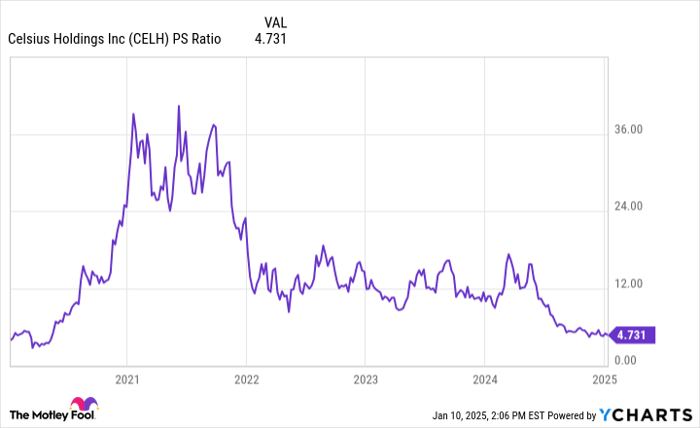Shares of energy drink company Celsius (NASDAQ: CELH) plunged 51.7% in 2024, according to data provided by S&P Global Market Intelligence, which is bad enough. But in the opening months of the year, the stock was up 76%. This means that while it dropped 52% for the year, it dropped a whopping 73% from its high point in 2024.
Rumblings of a problem began after Celsius reported financial results for the first quarter of 2024 in May. The company missed expectations for revenue -- rare for this high-growth business. Management mentioned that its largest customer, which is PepsiCo through a distribution agreement, was having inventory management issues. Otherwise, its Q1 revenue would have lived up to expectations.
Start Your Mornings Smarter! Wake up with Breakfast news in your inbox every market day. Sign Up For Free »
Investors mostly shrugged off this concern at the time. But as the year rolled on, it was clear that this inventory issue was a major headwind for Celsius. And by the third quarter of 2024, the company's revenue plunged 31% year over year. This was the first time it posted negative growth since 2018.
Going from recent triple-digit growth to a revenue decline got investors' attention. They've been selling Celsius stock, dropping it to its lowest price-to-sales valuation in nearly five years.
Data by YCharts.
This problem for Celsius isn't uncommon
With supply chains, there's a phenomenon known as the bullwhip effect. Supply chains involve multiple parties, but eventually end with a customer. A small spending change with customers can cause more pronounced adjustments with each link in the chain as it makes its way back to the originator. And that seems to be what's happening here.
In recent years, Celsius rose from obscurity to having the third-largest market share in the energy drink space. Revenue was doubling in a single year. But consumers cut back on spending on energy drinks in 2024, which seems to have caught Pepsi off guard. It overestimated the requisite inventory to keep up with consumer demand. It made a more pronounced adjustment to correct its error, leading to Celsius' revenue drop.
Unfortunately for shareholders, Celsius was on the wrong end of the bullwhip.
What should Celsius investors do?
Stoic investors would ideally cut through the present noise to size up the long-term opportunity for Celsius. That said, that's not a simple task in this case. It's increasingly difficult to discern whether Celsius' products are still resonating with consumers. If it's losing ground to rivals, that's concerning.
For its part, Celsius says that its products are indeed still resonating with consumers, which is good. The company says its Q1 market share was 11.4% compared with 12.1% market share year-to-date as of Q3.
Assuming that Celsius doesn't have a consumer demand problem, then 2025 could provide some promising upside. The company is still expanding into new sales channels as well as entering new markets. These new opportunities could surprise investors by getting its growth back on track.
Don’t miss this second chance at a potentially lucrative opportunity
Ever feel like you missed the boat in buying the most successful stocks? Then you’ll want to hear this.
On rare occasions, our expert team of analysts issues a “Double Down” stock recommendation for companies that they think are about to pop. If you’re worried you’ve already missed your chance to invest, now is the best time to buy before it’s too late. And the numbers speak for themselves:
- Nvidia: if you invested $1,000 when we doubled down in 2009, you’d have $352,417!*
- Apple: if you invested $1,000 when we doubled down in 2008, you’d have $44,855!*
- Netflix: if you invested $1,000 when we doubled down in 2004, you’d have $451,759!*
Right now, we’re issuing “Double Down” alerts for three incredible companies, and there may not be another chance like this anytime soon.
*Stock Advisor returns as of January 6, 2025
Jon Quast has positions in Celsius. The Motley Fool has positions in and recommends Celsius. The Motley Fool has a disclosure policy.
The views and opinions expressed herein are the views and opinions of the author and do not necessarily reflect those of Nasdaq, Inc.



